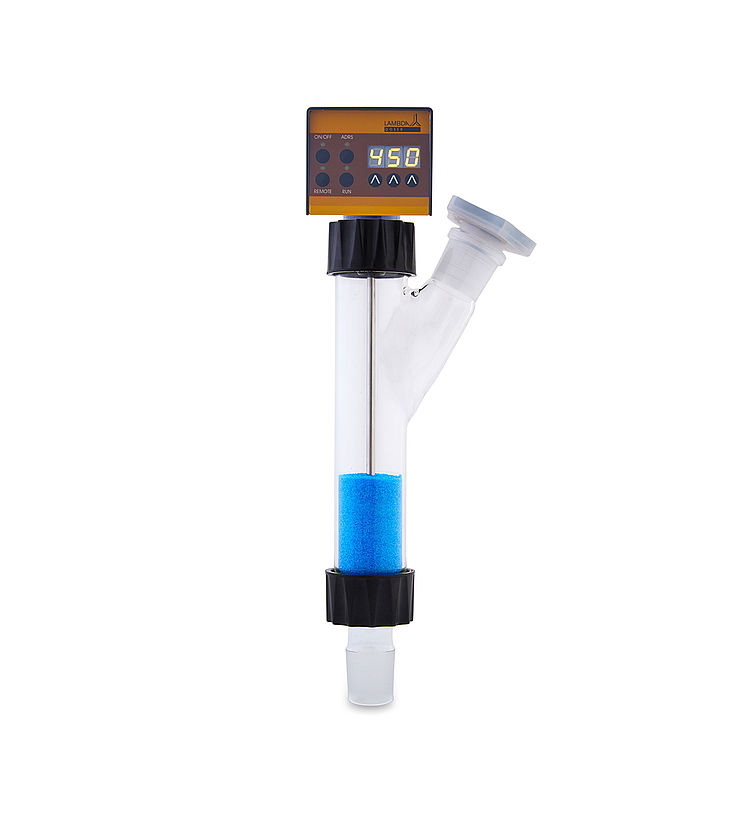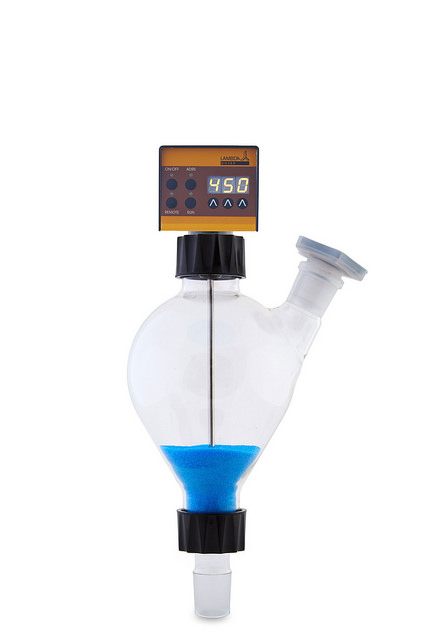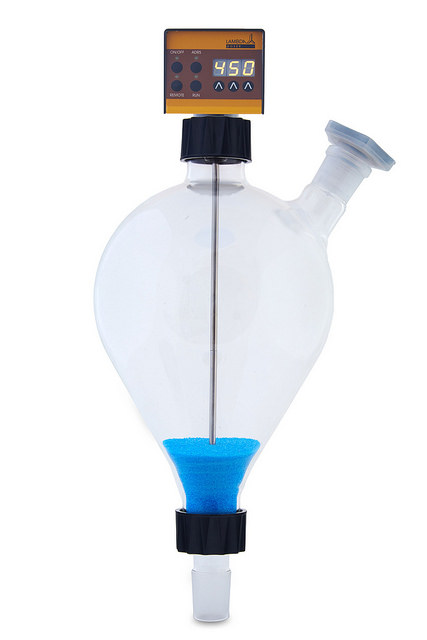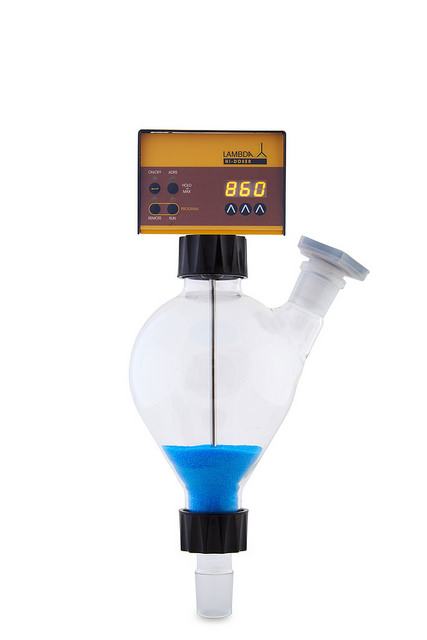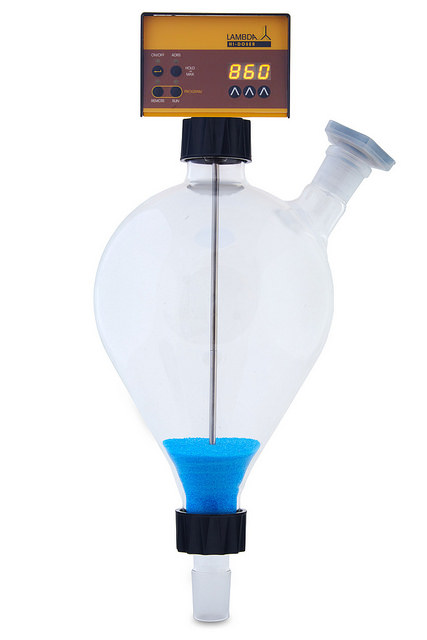Doseur de poudre
Doseur de poudre
LAMBDA DOSER / Hi-DOSER est un doseur automatique de poudre qui permet la dosage de poudres, de granulés, de cristaux, de substances solides et de réactifs.
Le doseur de poudres LAMBDA DOSER / Hi-DOSER est une pompe programmable unique pour substances solides fluides (ruisselantes). Le LAMBDA DOSER / Hi-DOSER permet l'addition automatique ou en continu de poudres, substances poudreuses et cristallines.
Le doseur de poudres qui modernisera votre laboratoire
Le doseur de poudres LAMBDA DOSER / Hi-DOSER modernisera votre laboratoire: Le doseur de poudres consiste d'une unité de dosage et d'un moteur pas-à-pas contrôlé digitalement par une électronique moderne. Le LAMBDA DOSER / Hi-DOSER permet ainsi un dosage constant et reproductible. Le doseur de poudre offre différentes possibilités de contrôle à distance est se prête particulièrement bien pour le contrôle automatique d'une multitude de processus.
Images: www.lambda-instruments.com/fr/doseur-de-poudre/doser-hidoser-images/
Propriétés du doseur de poudres LAMBDA DOSER / Hi-DOSER
Les propriétés du doseur de poudre LAMBDA DOSER / Hi-DOSER sont les suivantes:
Vitesse de dosage de poudre
Le contrôle digital de la vitesse de dosage de 0 à 999 permet une bonne reproductibilité du débit (p.ex. NaCl):
- 50 mg/min à 50 g/min de NaCl pour le LAMBDA DOSER
- 250 mg/min à 250 g/min de NaCl pour le LAMBDA HI-DOSER (FAST mode)
- 60 mg/min à 60 g/min de NaCl pour le LAMBDA HI-DOSER (SLOW mode)
LAMBDA DOSER et Hi-DOSER sont programmables
Vitesse de dosage et temps de dosage peuvent être facilement programmés:
- DOSER: jusqu’à 27 pas avec vitesse et durée
- Hi-DOSER: jusqu’à 99 pas avec vitesse et durée
Capacité
Récipient de verre d’environ 200 ml (correspond à 250 g de NaCl, 200 g de NaHCO3, 150 g de sucrose). Cette capacité est optimale pour la plupart des travaux de laboratoire. Les récipients plus grands d’environ 1l et 3L sont aussi disponibles.
Sécurité
Grâce au LAMBDA DOSER / Hi-DOSER l’addition de substances chimiques pulvérulentes devient reproductible, sûre et conforme aux normes de sécurité et standards de qualité (GLP), comme ils sont prescrits pour la manipulation de produits chimiques au laboratoire. Sa construction hermétique permet la manipulation sûre de substances solides dangereuses et toxiques.
Atmosphère contrôlée
Plusieurs joints assurent l’étanchéité du doseur qui peut être donc utilisé avec une légère surpression ou un faible vide. Si une réaction le requiert, l’appareil peut aussi être rincé avec un gaz inerte au cours du dosage.
Montage et nettoyage faciles
Le LAMBDA DOSER / Hi-DOSER a été construit de façon à permettre un montage simple et un nettoyage facile.
Le doseur de poudre peut être connecté à tout récipient de verre muni d’un rodage standardisé NS 29/32 ou une connexion à vis SVL. T
outes les parties en contact avec les substances pulvérulentes sont fabriquées de matériaux chimiquement résistants.
Faibles dimensions
Une attention toute particulière a été portée sur la minimisation de la taille du doseur. Par conséquent le LAMBDA DOSER / Hi-DOSER peut être facilement monté sur des appareillages de laboratoire complexes. Sa construction robuste et la haute qualité du matériel utilisée assurent au LAMBDA DOSER / Hi-DOSER une longue durée de vie.
Les dimensions vous trouver sur www.dosage-poudres.com/specifications-techniques/ .
Dosage de poudre économique
L’addition automatique de substances solides libère l’expérimentateur pour d’autres travaux. Le doseur permet la réduction du nombre d’expériences grâce à une meilleure reproductibilité du débit et évite la répétition d’expériences due aux erreurs de manipulation. Le LAMBDA DOSER / Hi-DOSER présente un excellent rapport qualité-prix.
Contrôle à distance pour la dosage de poudre
Le contrôle à distance permet la commande de la vitesse de dosage de poudre sur toute la plage de vitesse de rotation par l’application d’une tension entre 0 et 10V. L’enclenchement et le déclenchement (ON/OFF) est effectué par un simple contact externe ou un signal de 12 V.
L’interface RS-485 ou RS-232 (en option) permet une commande avancée depuis l’ordinateur (débits variables, gradients de dosage etc.)
Un logiciel de contrôle PNet est aussi disponible en option.
Quantification du dosage de poudre
Le LAMBDA DOSER / Hi-DOSER peut être configuré avec l’intégrateur électronique LAMBDA INTEGRATOR (en option) qui permet de déterminer la quantité de poudre ajoutée en fonction du temps. LAMBDA INTEGRATOR fournit des informations importantes sur le processus et les réactions quand le doseur est réglé p.ex. par un pH-stat, thermostat etc.
Programmation: DOSER: jusqu'à 27 pas avec vitesse et durée; Hi-DOSER: jusqu'à 99 pas avec vitesse et durée
Résolution temporelle: De 0 à 999 minutes par pas de 1 minute ou de 0 à 99.9 minutes par pas de 0.1 minute, la résolution de temps peut être sélectionnée individuellement pour chaque pas de programmation
Moteur: DOSER: Moteur pas à pas contrôlé par microprocesseur; Hi-DOSER: Moteur sans balai à courant continu (BLDC) pourvu d’aimants au néodymium contrôlé par microprocesseur
Gamme de vitesses: 0 à 999
Interface: RS-485 ou RS-232 (option)
Alimentation électrique: DOSER: Alimentation 95–240 V/50–60 Hz AC avec sortie DC 12V/12W; possibilité d’utiliser une batterie 12 V; Hi-DOSER: Alimentation 95–240 V/50–60 Hz AC avec sortie DC 12V/50W; possibilité d’utiliser une batterie 12 V (types de prises: AU, CH, EU, UK, US)
Volume: Cuve en verre d’env. 0.2 L, 1 L ou 3 L
Dimensions: DOSER: Bloc moteur: 6 (H) x 7 (L) x 13 (P) cm; Hi-DOSER: Bloc moteur: 10.5 (L) x 9.5 (H) x 13 (P) cm; Cuve en verre de 0.2 l: 30 (H) x 12 (L) x 5 (P) cm; Cuve en verre de 1 l: 30 (H) x 18 (L) x 14 (P) cm; Cuve en verre de 3 l: 38 (H) x 21 (L) x 17.5 (P) cm.
Sécurité: CE, selon la norme IEC 1010/1 pour les instruments de laboratoire
Température de fonctionnement: 0 - 40 °C
Humidité de fonctionnement: 0-90 % RH, sans condensation
Contrôle à distance: 0-10 V (contrôle de la vitesse); 3-12 V DC (contrôle ON/OFF); option 0-20 ou 4-20 mA; pédale marche-arrêt
Software: PNet, logiciel pour PC (option)
- DE - Pulverdosiergerät LAMBDA DOSER und HI-DOSER - Prospekt (pdf)
- DE - Bedienungsanleitung - LAMBDA DOSER Pulverdosiergerät (pdf)
- ES - Dosificador de solidos LAMBDA DOSER / HI-DOSER (pdf)
- ES - Instrucciones de uso - Dosificadora de sólidos y sustancias pulverulentas LAMBDA DOSER (pdf)
- RU - Дозаторы порошков LAMBDA DOSER и HI-DOSER - Листовка (pdf)
- RU - Руководство по эксплуатации - Дозаторы порошка LAMBDA DOSER и HI-DOSER (pdf)
- FR - Mode d'emploi - LAMBDA DOSER doseur de poudres programmable (pdf)
- FR - LAMBDA DOSER / HI-DOSER doseur de poudres programmable - brochure (pdf)
- CZ - Návod k obsluze - Dávkovač pevných, krystalických látek a prášků LAMBDA DOSER (pdf)
- CZ - Automatický dávkovač pevných, krystalických látek a prášků LAMBDA DOSER (pdf)
- EN - LAMBDA DOSER and HI-DOSER powder dosing instrument - Leaflet (pdf)
- EN - Operation manual - LAMBDA DOSER and HI-DOSER powder dosing instrument (pdf)
- EN - Application note - LAMBDA powder DOSER - Reproducible powder dosing (pdf)
2024
Un produit solide composé de silice humide traitée thermiquement a été chargé dans le DOSEUR de poudre de LAMBDA et ajouté au réacteur.
Luo, L., Rix, F. C., Stevens, K. A., Kuo, C. L., Zhang, X., Lovell, J. A., Harlan, C.J., Ye, X., & Berg, B. R. (2024). Improved In-Situ MAO Derived Silica Supported Single-Site Metallocene Catalysts. U.S. Patent Application No. 18/253,867.
https://patents.google.com/patent/US20240092947A1/en (2024 June 17)
Pour des expériences de « pyrolyse flash », de la biomasse en poudre (mélange de cellulose, hémicellulose, lignine et cendres) a été introduite dans conduite d'azote à l'intérieur d'un venturi à l'aide d'une pompe à poudre LAMBDA Hi-DOSER à un débit compris entre 1 et 20 g/mn.
Proust, C., Proust, M., & Foyer, J. (2024, February). High temperature pyrolysis of lignocellulosic biomass for biogas production. In Technological Systems, Sustainability and Safety.
https://hal.science/hal-04538203 (2024 mai 14)
Études de ségrégation des solides : Le distributeur de solides situé au sommet du réacteur à lit fluidisé est un LAMBDA DOSER 3L ajoutant du solide en continu à une vitesse allant jusqu'à 13.7 g/min.
Ciércoles, R., Lasobras, J., Soler, J., Herguido, J., & Menéndez, M. (2024). A Preliminary Assessment of Sorption Enhanced Methanol Synthesis in a Fluidized Bed Reactor with Selective Addition/Removal of the Sorbent. Removal of the Sorbent.
https://dx.doi.org/10.2139/ssrn.4735903
Avant de commencer la pyrolyse, 6 g de matériaux ont été mélangés uniformément et ajoutés au doseur DOSER 0.2L de LAMBDA
Wang, X., Peng, Y., Zhou, R., Fan, L., Zhang, Q., Cui, X., Wu, Q., Zeng, W., Tian, X., Ke, L., Ruan, R., & Wang, Y. (2024). Production of monocyclic aromatic hydrocarbons from microwave co-pyrolysis of polyethylene terephthalate and low-density polyethylene using coconut husk carbon as microwave absorbent. Chemical Engineering Journal, 150732.
https://doi.org/10.1016/j.cej.2024.150732
Étude sur l'importance des caractéristiques des matières premières (humidité, matières volatiles, teneurs en carbone fixe et en cendres) pendant l'étape d'alimentation en particules pour la gazéification par courant descendant des déchets de biomasse : un équipement de dosage de poudre (LAMBDA DOSER 0.2L) a été utilisé pour l'alimentation en particules (déchets de palmier dattier, grignons d'olive, boues d'épuration) afin de tester l’influence du débit du gazogène, la puissance nominale et la durée de stockage.
Khan, S., Adeyemi, I., Moustakas, K., & Janajreh, I. (2024). Investigating the characteristics of biomass wastes via particle feeder in downdraft gasifier. Environmental Research, 118597.
https://doi.org/10.1016/j.envres.2024.118597
2023
L'équipement de dosage automatique LAMBDA DOSER a été utilisé pour fournir en continu 70 à 80 % d'Al2O3 requis pour une efficacité théorique de 100 %. Les limites du système dues à un colmatage critique du canal d'alimentation en alumine ont été atteintes dans certains cas après 6 à 10 h.
Singh, K., Gunnarsson, G., Magnusson, J. H., Haarberg, G. M., & Saevarsdottir, G. (2023). Performance Evaluation of Low-Temperature KF-NaF-AlF3 Electrolytes for Aluminum Electrolysis Using Vertical Inert Cu–Ni–Fe Alloy Anodes. Journal of The Electrochemical Society, 170(11), 113507.
https://doi.org/10.1149/1945-7111/ad0bae
Batterie lithium-ion : alimentation d’un précurseur en poudre (silicium et ferrocène [Fe(C5H5)2] ; 1 g/min) dans une colonne à plasma soutenu par ondes de surface (SWS) (température centrale > 4 000 K)
Jie, Z., Zhang, Z., Bai, X., Ma, W., Zhao, X., Chen, Q. & Zhang, G. (2023). Surface-wave-sustained plasma synthesis of graphene@Fe–Si nanoparticles for lithium-ion battery anodes. Appl. Phys. Lett. 11 September 2023; 123 (11): 113902.
https://doi.org/10.1063/5.0159269
2022
Un échantillon de granulés HDPE a été placé dans le doseur de granulés en verre (LAMBDA DOSER 1L)
Dai, L., Zhou, N., Lv, Y., Cobb, K., Chen, P., Wang, Y., Liu, Y., Zou, R., Lei, H., Mohamed, B. A., Ruan, R., & Cheng, Y. (2022). Catalytic reforming of polyethylene pyrolysis vapors to naphtha range hydrocarbons with low aromatic content over a high silica ZSM-5 zeolite. Science of The Total Environment, 847, 157658.
https://doi.org/10.1016/j.scitotenv.2022.157658
Canal expérimental pour la séparation des particules magnétiques : Dans un premier temps, les cendres volantes ont été dosées par un système de dosage de LAMBDA avec un récipient de 1 L (monté au-dessus d'un plateau au milieu de la section transversale du canal) dans le canal horizontal et ont été dispersées par de l'air comprimé (3 bars) s'écoulant d'une buse plate sur le plateau (voir Figure 1 de la publication).
Czech, T. (2022). Morphology and chemical composition of magnetic particles separated from coal fly ash. Materials, 15(2), 528.
https://doi.org/10.3390/ma15020528
Addition de poudre d'Al2O3 et d'autres particules tamisées et séchées dans un générateur d'aérosol en boucle fermée : Les particules ont été ajoutées avec un doseur de poudre volumétrique DOSER 0.2 L de LAMBDA dans un raccord en T de 1⁄4" dans lequel a poudre a été captée par un flux d'air comprimé (5 L/min) et guidé sous forme d'aérosol à travers le flux de l'installation.
Prüfert, C., Beitz, T., Reich, O. & Löhmannsröben, H.-G. (2022). Inline process analysis of copper-bearing aerosols using laser-induced breakdown spectroscopy, laser-induced incandescence and optical imaging. Spectrochimica Acta Part B: Atomic Spectroscopy 197 (2022) 106527.
https://doi.org/10.1016/j.sab.2022.106527
Des particules de charbon ont été introduites dans un réacteur via une pompe à poudre programmable contrôlé par microprocesseur purgée au N2 (Hi-DOSER, LAMBDA) positionné au-dessus du tube du réacteur. L'avantage de ce doseur est que la quantité d'alimentation est relativement uniforme, évitant le colmatage de l’embouchure et l’instabilité de la production de gaz.
Dai, T., Xu, C., Zhang, Q., Liu, X., Chang, Z. & Yang, Y. (2022). Experimental study of the solar-driven steam gasification of coal in an improved updraft combined drop-tube and fixed-bed reactor. Energy Conversion and Management, Volume 259,2022,115571,ISSN 0196-8904.
https://doi.org/10.1016/j.enconman.2022.115571
La chaleur de dissolution intégrale de la neutralisation acido-basique a été mesurée dans un réacteur agité à l'aide d'un calorimètre réactionnel (RC1e, Mettler Toledo Ltd.) tandis que le LAMBDA DOSER alimentait en continu l'acide ou la base sous forme solide : 23.6 g/min d'acide citrique ; 30 g/min de NaOH ; 21 g/min de NaOH ; 14.8 g/min de NaOH ; 7.2 g/min de NaOH
Ran, Z., Ni, L., Pan, Y., Chen, Y., Wang, J., Jiang, J. & Shu, C-M. (2022). Safety Criteria for Solid–Liquid Heterogeneous Systems in Semibatch Reactors. ACS Omega 2022 7 (24), 21207-21219
https://doi.org/10.1021/acsomega.2c02139
Le taux de chargement du minerai de fer est directement ajusté via l'instrument de dosage de poudre.
Zarl, M. A., Ernst, D., Cejka, J., & Schenk, J. (2022). A New Methodological Approach to the Characterization of Optimal Charging Rates at the Hydrogen Plasma Smelting Reduction Process Part 1: Method. Materials, 15(14), 4767.
https://doi.org/10.3390/ma15144767
Dosage du minerai de fer de Carajas.
Ernst, D., Zarl, M. A., Cejka, J., & Schenk, J. (2022). A New Methodological Approach on the Characterization of Optimal Charging Rates at the Hydrogen Plasma Smelting Reduction Process Part 2: Results. Materials, 15(12), 4065.
https://doi.org/10.3390/ma15124065
Dispositif expérimental de pyrolyse catalytique : Un doseur programmable (LAMBDA DOSER 1L) distribuait des granulés de plastique, généralement à un taux d'alimentation de 120 g/h, dans un réacteur en quartz, qui contenait 1 kg de billes de carbure de silicium de 8 mm. Le lit à billes a été chauffé et maintenu à 500 °C pour tous les tests de cette étude par un système de chauffage micro-ondes programmable.
Zhou, N., Dai, L., Lyu, Y., Wang, Y., Li, H., Cobb, K., Chen, P., Lei, H. & Ruan, R. (2022). A structured catalyst of ZSM-5/SiC foam for chemical recycling of waste plastics via catalytic pyrolysis. Chemical Engineering Journal, Volume 440, 2022, 135836, ISSN 1385-8947.
https://doi.org/10.1016/j.cej.2022.135836
2021
Étude de cristallisation par réaction en semi-batch : le solide a été distribué par un LAMBDA DOSER 0.2L et un lent courant d'air sous pression a été évacué à travers l’appareil. Trois solides ont été utilisés pour le dosage : CL-20 (150 μm), HMX fin (5 μm) et HMX grossier (300 μm). En mélangeant le HMX utilisé grossièrement à finement à 5:1, une distribution reproductible a été obtenue.
Herrmannsdörfer, D., & Klapötke, T. M. (2021). Semibatch reaction crystallization for scaled-up production of high-quality CL-20/HMX cocrystal: efficient because of solid dosing. Crystal growth & design, 21(3), 1708-1717.
https://doi.org/10.1021/acs.cgd.0c01611
Dosage solide : Un mélange de 90 g de CL-20 (205 mmol), 25 g de HMX grossier (84 mmol) et 5 g de HMX fin (17 mmol) a été distribué par un LAMBDA DOSER 0.2L. Un lent courant d'air sous pression a été évacué à travers le doseur de solide pour empêcher la cimentation du solide due aux vapeurs d'acétonitrile.
Herrmannsdörfer, D., & Klapötke, T. M. (2021). Quality Assessment of the CL‐20/HMX Cocrystal Utilising Digital Image Processing. Propellants, Explosives, Pyrotechnics, 46(4), 522-529.
https://doi.org/10.1002/prep.202000341
Conception expérimentale pour la conversion des NOx, comprenant un réacteur à entraînement vertical et des systèmes de surveillance des gaz : un doseur de poudre électronique calibré (Lambda Laboratory Instruments) alimente le plastique recyclé (pulvérisé cryogéniquement, 150 à 355 μm) à un faible taux d'alimentation constant de 7 mg/min, à travers une sonde refroidie à l'eau, dans un réacteur à quartz logé dans un four à trois zones chauffé électriquement..
Oluwoye, I., Zeng, Z., Mosallanejad, S., Altarawneh, M., Gore, J., & Dlugogorski, B. Z. (2021). Controlling NOx emission from boilers using waste polyethylene as reburning fuel. Chemical Engineering Journal, 411, 128427.
https://doi.org/10.1016/j.cej.2021.128427
Système d'alimentation en minerai de fer et chaux : Le chargement en continu s'effectue à l'aide d'un système d'alimentation en poudre LAMBDA DOSER 0.2L. Le minerai le plus fin avait de fortes propriétés adhésives et provoquait des agglomérations, qui ont été partiellement évités par un préchauffage dans une étuve à 120 °C.
Cejka, J. (2021). Parameterevaluierung für den kontinuierlichen Chargiervorgang von Eisenerzen und Zuschlägen im Wasserstoff-Plasma-Schmelzreduktionsprozess. Masterarbeit, Montan Universität Loeben.
https://pureadmin.unileoben.ac.at/ws/files/7814331/AC16360490.pdf (2024 April 02)
Détermination de la solubilité de l'acide itaconique dosé avec une pompe à poudre LAMBDA DOSER 0.2L pilotée par automate.
Holtz, A., Görtz, J., Kocks, C., Junker, M., & Jupke, A. (2021). Automated measurement of pH-dependent solid-liquid equilibria of itaconic acid and protocatechuic acid. Fluid Phase Equilibria, 532, 112893.
https://doi.org/10.1016/j.fluid.2020.112893
2020
Production de nanomatériaux par plasma: Les précurseurs en poudre sont introduits à l'aide d'un distributeur de poudre rotatif LAMBDA DOSER alimenté par gravité et qui est connecté à l'entrée du tube de travail.
Graves, B., Engelke, S., Jo, C., Baldovi, H. G., De la Verpilliere, J., De Volder, M., & Boies, A. (2020). Plasma production of nanomaterials for energy storage: continuous gas-phase synthesis of metal oxide CNT materials via a microwave plasma. Nanoscale, 12(8), 5196-5208.
https://doi.org/10.1039/C9NR08886E
www.rsc.org/suppdata/c9/nr/c9nr08886e/c9nr08886e1.pdf (2024 April 02)
Mise à l'échelle de la procédure Dakin-West utilisant de l'acide glutamique à l'échelle de 100 grammes réalisée dans une configuration automatisée avec un DOSER de LAMBDA pour solides
Würdemann, M. A., Niţu, C., De Wildeman, S. M., Bernaerts, K. V., & Orru, R. V. (2020). The Forgotten Pyrazines: Exploring the Dakin–West Reaction. Chemistry–A European Journal, 26(36), 8090-8100.
https://doi.org/10.1002/chem.202000475
Système d'alimentation en minerai de fer et en chaux : l'instrument de dosage de poudre Hi-DOSER 1L fabriqué par LAMBDA Laboratory Instruments a été utilisé pour charger le mélange de minerai de fer et des additifs fins en continu dans le creuset en acier pendant les tests.
Naseri Seftejani, M. (2020). Reduction of hematite using hydrogen plasma smelting reduction (Doctoral Thesis, Montanuniversitaet Leoben).
https://pure.unileoben.ac.at/en/publications/reduction-of-hematite-using-hydrogen-plasma-smelting-reduction (2024 Feb. 26)
Équipement de laboratoire pour le processus de réduction par fusion par plasma d'hydrogène (HPSR) : Le système de dosage de poudre LAMBDA Hi-DOSER 0.2L de LAMBDA a été utilisé pour introduire en continu ~3 g/min de minerai de fer hématite de Carajas avec le gaz (40 % d'hydrogène dans l'argon) à travers l’électrode creuse en graphite (HGE, diamètre intérieur 5 mm).
Zarl, M. A., Farkas, M. A., & Schenk, J. (2020). A study on the stability fields of arc plasma in the HPSR process. Metals, 10(10), 1394.
https://doi.org/10.3390/met10101394
Doseur de poudre sur four tubulaire vertical pour le dosage de 0.6 à 0.7 g/min de charbon pulvérisé
Gao, R., Dou, B., Chang, Q., Xu, J., Dai, Z., Yu, G., & Wang, F. (2020). Effect of temperature and hydrogen on product distribution and evolution of char structure during pyrolysis of bituminous coal in a drop tube furnace. Shanghai Engineering Research Center of Coal Gasification, East China University of Science and Technology, Shanghai 200237, PR China.
https://doi.org/10.1016/j.fuel.2020.117078
Alimentation continue de 80 g de mélange de minerai de fer et de chaux en 1380 secondes avec le système de dosage de poudre LAMBDA Hi-DOSER 1L
Seftejani, M. N., Schenk, J., Spreitzer, D., & Zarl, M. A. (2020). Slag Formation during Reduction of Iron Oxide Using Hydrogen Plasma Smelting Reduction. Materials 2020, 13, 935;
https://doi.org/10.3390/ma13040935
2019
Préparation et dosage de la charge d'alumine : Pour éliminer toute humidité, l'alumine a été maintenue dans une étuve à 300 °C pendant une nuit puis stockée dans un dessiccateur jusqu'au test d'électrolyse. Un LAMBDA DOSER a été utilisé pour l’alimentation continue d’alumine (débits d’alimentation : 200 – 400 mg/min).
Medino, C. M. (2019). Improving current efficiency in low-temperature aluminum electrolysis with vertical inert electrodes (Doctoral dissertation).
URI: https://hdl.handle.net/1946/33817 (2024 Mar 27)
L'hydrolyse enzymatique Fed-batch a été réalisée dans un bioréacteur : l'opération d'alimentation en biomasse prétraitée a été contrôlée par un DOSEUR de LAMBDA programmé. (Teneur en humidité du substrat : 2.38 %)
Tai, C., & Keshwani, D. (2019). System for optimizing fed-batch hydrolysis of biomass. U.S. Patent No. 10,501,766. Washington, DC: U.S. Patent and Trademark Office.
https://patentimages.storage.googleapis.com/a7/d9/fa/6c34de7d414bd1/US10501766.pdf (2024 avril 02)
Alimentation en alumine : pendant l'électrolyse, de l'alumine (oxyde d'aluminium) a été introduite en continu dans l'électrolyte avec un équipement de dosage fourni par LAMBDA Laboratory Instruments. Le LAMBDA DOSER a été utilisé pour fournir en continu environ 70 à 80 % de l'alumine nécessaire pour effectuer l'électrolyse avec une efficacité de courant de 100 %.
Gunnarsson, G., Óskarsdóttir, G., Frostason, S., & Magnússon, J. H. (2019). Aluminum electrolysis with multiple vertical non-consumable electrodes in a low temperature electrolyte. In Light Metals 2019 (pp. 803-810). Springer International Publishing.
https://doi.org/10.1007/978-3-030-05864-7_98
Configuration expérimentale : A) système d'alimentation en gaz et solide LAMBDA DOSER ; B) zone de réaction et four électrique ; C) système de détection optique
Díaz, W., Toro, C., Balladares, E., Parra, V., Coelho, P., Reyes, G., & Parra, R. (2019). Spectral characterization of copper and iron sulfide combustion: A multivariate data analysis approach for mineral identification on the blend. Metals, 9(9), 1017.
https://doi.org/10.3390/met9091017
2018
Gazéificateur hybride solaire/autothermique : le tube SiC a été fabriqué avec un trou coudé de 45° et 16.7 mm de diamètre à l'arrière pour permettre l'acheminement de matières premières à partir d'un distributeur de poudre LAMBDA DOSER. Elles sont entraînées par gravité via un tube Al2O3. Le distributeur a été purgé avec Ar dans le récipient de charge et à la partie inférieure de l’appareil à un débit constant de 2 LN/min pour empêcher le reflux des gaz réactifs. Le distibuteur a été calibré avec la purge Ar à un débit d’alimentation d’environ 60 g/h. Les taux d'alimentation avec des intervalles de confiance à 95 % étaient de 57.5 ± 2.7 g/h pour le charbon actif et de 62.3 ± 8.81 g/h pour le lignite.
Muroyama, A. P., Guscetti, I., Schieber, G. L., Haussener, S., & Loutzenhiser, P. G. (2018). Design and demonstration of a prototype 1.5 kWth hybrid solar/autothermal steam gasifier. Fuel, 211, 331-340.
https://doi.org/10.1016/j.fuel.2017.09.059
2016
Alimentation en substrat en fedbatch avec un doseur de poudre DOSER de LAMBDA contrôlée via la concentration de glucose dans le fermenteur (Système de contrôle à logique floue – LabVIEW)
Tai, C., Voltan, D. S., Keshwani, D. R., Meyer, G. E., & Kuhar, P. S. (2016). Fuzzy logic feedback control for fed-batch enzymatic hydrolysis of lignocellulosic biomass. Bioprocess and biosystems engineering, 39, 937-944.
https://doi.org/10.1007/s00449-016-1573-1
2015
Pyrolyse et détermination des paramètres cinétiques avec un DOSER 1L de LAMBDA pour l’alimentation en poudre : Le système de fluidisation alimente les résidus solides d'hydrolyse acide (AHR) de miscanthus à débit sensiblement constant et sans blocage. Dans certaines expériences, la biomasse est soudainement tombée dans le réacteur en raison du pontage et de l'agglomération électrostatique du matériau de départ. L'agglomération était facilement détruite en tapotant sur le récipient en verre. Le moteur a été réglé sur 005 (proche du minimum) pour atteindre des débits inférieurs à 1 g/min pour un débit de gaz de 8 L/min. Des améliorations sont envisagées pour obtenir différentes combinaisons de débit d'alimentation et de débit de gaz dans le but de modifier le temps de séjour des solides et le rapport d'équivalence pour la gazéification.
Cortes Benitez, A. (2015). Thermal processing of miscanthus, sugarcane bagasse, sugarcane trash and their acid hydrolysis residues (Doctoral dissertation, Aston University).
https://publications.aston.ac.uk/id/eprint/25492/3/Thermal_processing_of_miscanthus_sugarcane_bagasse_sugarcane_trash_and_their_acid_hydrolysis_residues.pdf (2024 April 02)
Biomasse lignocellulosique prétraitée (teneur en humidité 2.38 %) ajoutée dans un procédé fedbatch
Tai, C., Keshwani, D. R., Voltan, D. S., Kuhar, P. S., & Engel, A. J. (2015). Optimal control strategy for fed‐batch enzymatic hydrolysis of lignocellulosic biomass based on epidemic modeling. Biotechnology and bioengineering, 112(7), 1376-1382.
https://doi.org/10.1002/bit.25552
Étude de l’utilisation des sels inorganiques fondus dans le processus de pyrolyse : Le dispositif de dosage LAMBDA DOSER 0.2L a été rempli avec le mélange, composée de matière première (copeaux de bois de hêtre, Virgen-PET ou lignine Organosolv) et d'un mélange de sels de carbonate (mélange de sels de carbonate de Li2CO3 (purum), Na2CO3 (anhydre, à écoulement libre, Redi-Dri™, réactif ACS), K2CO3 (anhydre, à écoulement libre, Redi-Dri™, réactif ACS) de Sigma-Aldrich Chemie GmbH) et rincé avec azote : 5 g de matière première séchée ont été introduits constamment pendant 20 minutes dans le réacteur.
Nieberl, M. (2015). Parameterstudie zur thermochemischen Zersetzung organischer Materialien in geschmolzenen Salzen. Bachelor Thesis, Fraunhofer Institut für Chemische Technologie ICT, Pfinztal.
https://doi.org/10.24406/publica-fhg-282280 ,
https://publica-rest.fraunhofer.de/server/api/core/bitstreams/43fc3357-47ba-4bc4-a2d5-b6394d0131c0/content (2024 April 02)
2014
Ajout de particules de verre sphériques (simulation de gouttelettes de carburant dans un canal)
Bodoc, V., & Voicu, D. (2014, July). Experimental investigation of the infrared extinction limitations for vapor concentration measurement in a gas/particle flow. In 17th International Symposium on Applications of Laser Techniques to Fluid Mechanics.
HAL Id : hal-01079181 , version 1
https://hal.archives-ouvertes.fr/hal-01079181/document (2024 Feb 22)
Alimentation en particules de bagasse séchées et tamisées dans un réacteur
Krüsi, M. (2014). Heat transfer enhancement in a solar biomass gasifier. Eidgenössische Technische Hochschule ETH Zürich (Nr. 21821).
https://doi.org/10.3929/ethz-a-010256755
2013
Le réacteur est équipé du doseur de poudre LAMBDA DOSER pour ajouter du NaBH4 solide en continu
Muir, Sean S. (2013). Sodium borohydride production and utilisation for improved hydrogen storage. PhD Thesis. Australian Institute for Bioengineering and Nanotechnology, The University of Queensland.
https://doi.org/10.14264/uql.2016.540
2012
Ajout de poudre de chlorure de cuivre
Eiroma, K., Forsman, J., Hult, E.-L., Auvinen, A., Sipiläinen-Malm, T., Alastalo, A., Tapper, U., Leppäniemi, J., Mattila, P., Lyyränen, J., Sarlin, J., Jokiniemi, J., & Mössmer, S. (2012). Water-Based Carbon-Coated Copper Nanoparticle-Fluid Formation of Conductive Layers at Low Temperature by Spin Coating and Inkjet Deposition. Journal of Imaging Science and Technology, 56(4), 40501-1-40501-10 (10).
https://doi.org/10.2352/J.ImagingSci.Technol.2012.56.4.040501
2011
Ajout de particules dans un réacteur DTR
Hampp, F., & Janajreh, I. (2011). Development of a drop tube reactor to test and assist a sustainable manufacturing process. In Advances in Sustainable Manufacturing: Proceedings of the 8th Global Conference on Sustainable Manufacturing (pp. 141-148). Springer Berlin Heidelberg.
https://doi.org/10.1007/978-3-642-20183-7_21
Ajout continu de poudre de chlorure de cuivre sur un lit de pastilles d'alumine (Al2O3)
Eiroma, K., Auvinen, A., Forsman, J., Hult, E. L., Jokiniemi, J., Koskela, P., Sarlin, J., Sipiläinen-Malm, T., & Tapper, U. (2011, January). Development of conductive carbon coated copper nanoparticle inkjet fluid. In NIP & Digital Fabrication Conference (Vol. 2011, No. 2, pp. 458-461). Society for Imaging Science and Technology.
https://citeseerx.ist.psu.edu/doc_view/pid/d22f2a68bdaaa4054fc32e50d30afa87ef2c185c (2024 Feb. 22)
PDF: https://citeseerx.ist.psu.edu/document?repid=rep1&type=pdf&doi=d22f2a68bdaaa4054fc32e50d30afa87ef2c185c (2024 Feb. 22)
2007
Ajouts de particules en fonction du temps à l'aide de la pompe à poudre DOSER de LAMBDA pour étudier la fabrication et évaluer des composites à matrice métallique renforcée ferroélectrique (FR-MMC)
Poquette, B. D. (2007). Understanding Ferroelastic Domain Reorientation as a Damping Mechanism in Ferroelectric Reinforced Metal Matrix Composites (Doctoral dissertation, Virginia Tech).
https://hdl.handle.net/10919/29169 (2024 Feb. 22)
What is the lead time of Powder Doser?
We have DOSERs in stock and it can be delivered to you within a few days from order. Practically, it is only the time taken for shippingDo you accept Credit Card payments?
You can pay using your credit card via PayPal. Most importantly, it is not necessary to have a PayPal account to make the payment via credit card.Could you please confirm the particle size that can be fed by the dosing system?
The biggest particle size for powders that could be dosed with our DOSER is about 4 mm. A good dosing of powders depends essentially on the flowing properties of the respective powders to be dosed. In general, homogeneous and free-flowing powders can be dosed best.How does the LAMBDA DOSER work with the substances which are prone to agglomeration?
The powder / granules / solid must be properly treated for good flowing properties It is also possible to allow a gas flow to pass through the Lambda dosing vessel in order to create a controlled atmosphere.It is often possible to substantially improve the flowing properties of the respective powder / granules / solid by adding Aerosil (fumed silica – pure SiO2) to your powder (~0.1 - 2% by weight).
How the LAMBDA DOSER reacts to abrasive powders?
In the case of abrasive materials being used with the LAMBDA Powder DOSER, you will have an opportunity to replace the glass vessel and / or the distributors as needed.What is the accuracy of the each dispensing?
The motor of the driving unit is controlled with quartz-driven electronics, similarly as it is done in electronic watches.Therefore, the accuracy depends mainly on the powder. For best accuracy and precise doses, the powder needs to be free-flowing and homogeneous.Can the DOSER control the mass flow rate (g/min) of the powder being dispensed?
It is always possible to control the mass flow rate of the powder using the LAMBDA Doser. You could program the DOSER up to 27 pairs of speed and time settings to control your desired mass flow rate (g/min).Is it possible to control the DOSER via Mettler Toledo titroprocessor to dispense NaF to the titration process when required?
Yes, the powder DOSER can be controlled by Mettler Titration Excellence T50/T70/T90 via RS-232 communication (most common type of connection with Mettler accessories), to dispense the desired amount of powder to the titration process.The powder DOSER has to be included as RS-232 control in the titroprocessor unit and the desired activity can be selected (e.g.: the signal would switch off the DOSER or switch it on, etc.)
For integration of DOSER with your Mettler titroprocessor, you would need the RS-232 interface activated in the powder dosing unit and RS-232 connection cable.
